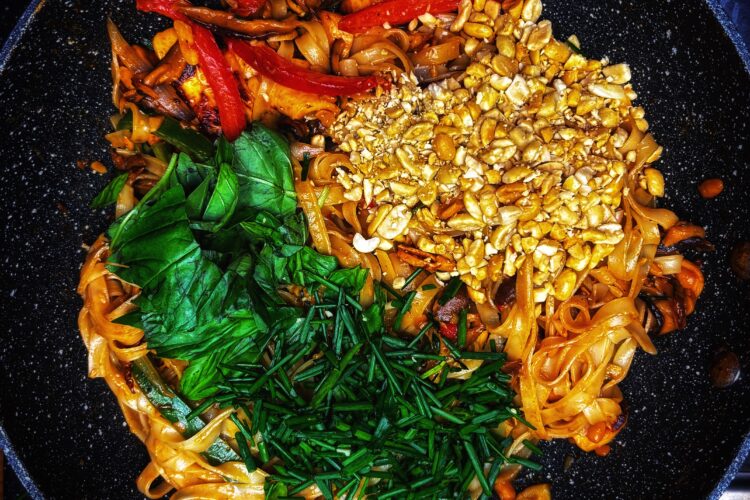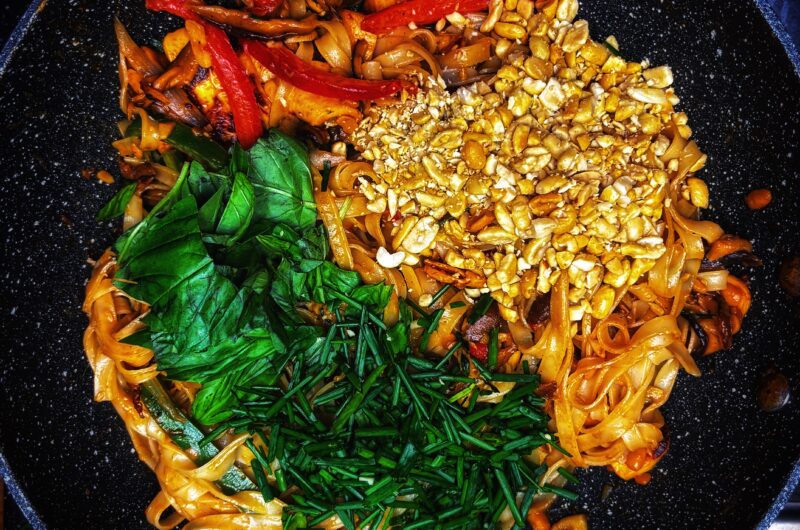This vegan (and optionally nut-free, gluten-free) Pad Thai recipe is just like the one at your favourite Thai takeaway
Skip to these parts:
Did you know that the Pad Thai is the most common order at about every Thai takeaway in the UK? Pad Thai is universally loved because of the perfect combination of freshness from limes and the umami from the irrestible Pad Thai sauce. However, have you ever wondered why the Pad Thai sauce you buy from a supermarket never makes noodles as irresistibly delicious as the ones from the takeaway down the street?
What if I were to tell you that a few simple kitchen tricks can help you achieve that goodness without compromising your health? This Pad Thai recipe is finger-lickin good; use this to impress your guests or help your family stay healthy!
Pad Thai Noodles: What you need
For the noodles (overnight prep recommended, can also be prepped before cooking)
Use 75-90 g of uncooked noodles per serving. This makes it c.350 g for 4 servings. I love using the Pad thai noodles from Oriental Food Co Ltd. It is Thai and be warned that the Vietnamese noodles used in Pho have a slightly different texture and feel compared to noodles used for Pad Thai. I recommend using Thai brands.
For the aromatic base
🔸 2 shallots, finely chopped
🔸 7-8 cloves purple garlic (or 3 cloves white garlic), finely chopped
🔸 2 Thai Bird’s Eye chilies, finely chopped (add more for higher heat or less if you prefer a mild dish)
🔸 ½ tsp cumin powder
For the protein and veggies
🔸 2 carrots, chopped into 2-inch batons
🔸 1.5 red bell pepper, julienned
🔸 1 white onion, julienned
🔸 250 g paneer or tofu, thinly sliced
The Pad Thai Sauce (can be prepper in advance or bulk, see recipe here)
🔸 4 tbsp Thai miso (Tao Jiew)
🔸 3 tbsp soy sauce (I use Chinese light soy sauce because it is quite similar to Thai soy sauce)
🔸 1.5 tbsp plain peanut butter
🔸 1 tsp palm sugar (or fine brown sugar)
🔸 ½-1 tsp vegan fish sauce (optional; this is quite salty and you might want to use it sparingly if you are new to this ingredient)
For the garnish and toppings
🔸 Splash of vinegar (1-2 tsp)
🔸 2-3 tbsp mung bean sprouts
🔸 2-3 tbsp chives, chopped
🔸 2-4 tbsp peanuts, roughly chopped
🔸 1 lime, wedged for serving
Pad Thai Noodles: Managing Dietary Requirements
Make it vegan: This Pad Thai recipe is vegan. We omit the seafood and fish sauce and use a natural vegan options like tofu for the chewy and smoky protein. Cold-marinating firm tofu for 24 hours in a mixture of soy sauce and vegan oyster sauce amps up the umami flavours.
Make it nut-free: If you are allergic to nuts, this might not be the most suitable recipe. This is because most Asian condiments have cross-contamination with peanuts. However, if you can find nut-free vegan fish sauce, oyster sauce, Tao Jiew and soy sauce, you can make this recipe completely nutfree by using sunflower butter instead of peanut butter. Skip the garnish with roasted and salted peanuts. Instead, you can garnish with lightly roasted pumpkin and sunflower seeds.
Make it gluten-free: Rice noodles is naturally gluten free. However, Tao Jiew and soy sauce tend to contain gluten. Therefore, you specifically need to source gluten-free soy sauce. The same is applicable for vegan fish sauce. Veggie oyster sauce may also contain traces of wheat so it is best to buy from a brand that specifically supplies gluten-free sauce. Certain brands like Lee Kum Kee offer gluten-free alternatives for most of these sauces. Finally, do note that Tao Jiew always contains wheat. You can substitute this 1:1 with white miso. Gluten-free miso is available in most supermarkets.
Pad Thai Noodles Recipe
1️⃣ Prepare the noodles
Use 75-90 g dry noodles per serve.
Method 1 (Soaking the noodles overnight): The most recommended method to get the best taste and texture is to soak the noodles overnight. Take a large bowl of cold water and soak the noodles for 8-10 hours. Drain the water and the noodles are ready to be tossed in. This acts slowly and makes the irresistibly chewy yet soft Pad Thai that Thai restaurants and takeaways seem to have.
Method 2 (Cooking the noodles in hot water): Soak the noodles in very hot water (70-80 degrees) for 45 minutes. This will result in chewy noodles but you might need to stir fry it in the wok for longer to make it soft.
2️⃣ Prepare the Thai Sauce (make it in bulk, recipe here)
This is something you can make in bulk and store for up to a month in the refrigerator. For this particular recipe, add 4 tbsp Tao Jiew to a bowl. Mash the beans with the back of your fork. Once they are almost mashed, add the 3 tbsp soy sauce, chopped chilies, palm sugar, vegan fish sauce, and peanut butter. Mix well till the peanut butter mixes with the rest of the ingredients to form a slurry.
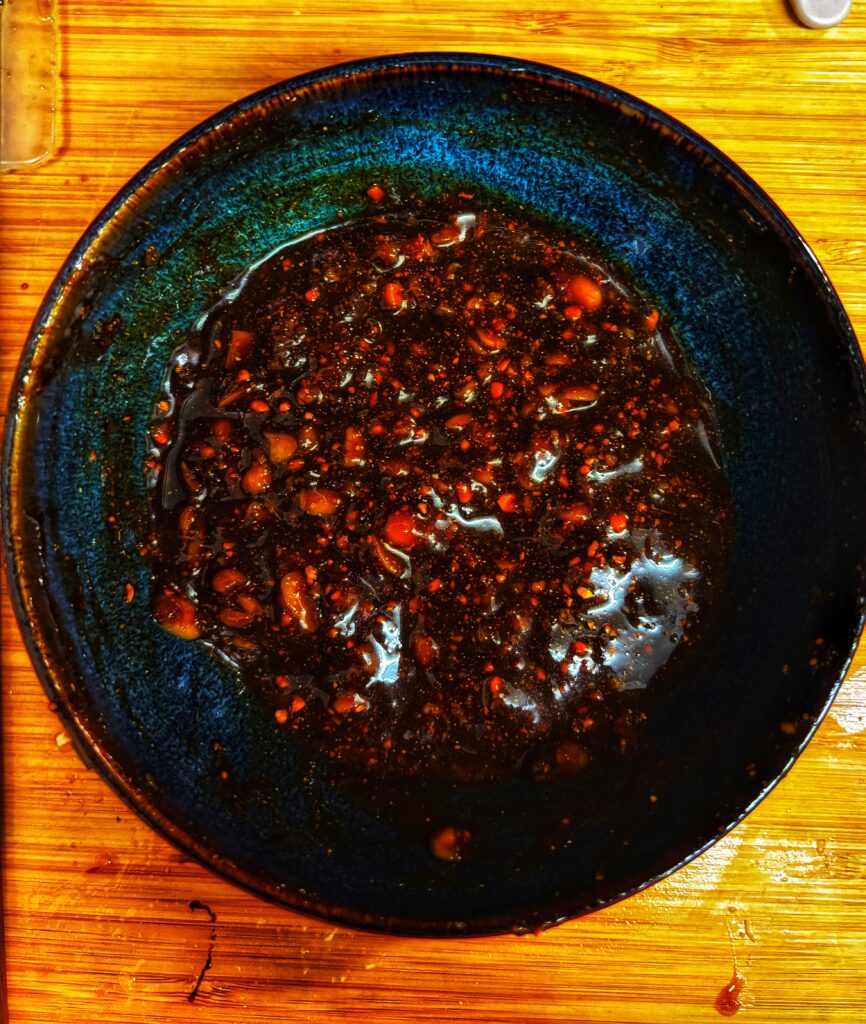
3️⃣ Prepare the protein (prep the tofu at least 24 hours in advance)
This step depends on whether you are using paneer or tofu. Thinly slice 200 g of your chosen protein.
If you are using tofu: Add the tofu to an airtight container with 4 tbsp oyster sauce. Combine well and marinate it in the refrigerator for at least 2 hours. This lets the tofu absorb the umami-rich flavours of the vegetarian oyster sauce.
If you are using paneer: Heat a pan 2 tsp of neutral oil (I use olive oil). Brush the oil well to spread it evenly on the pan. Add the thinly sliced paneer and 4 tbsp oyster sauce. Cook on a high heat and flip every 2-3 minutes to ensure all the sides are well caramelised.
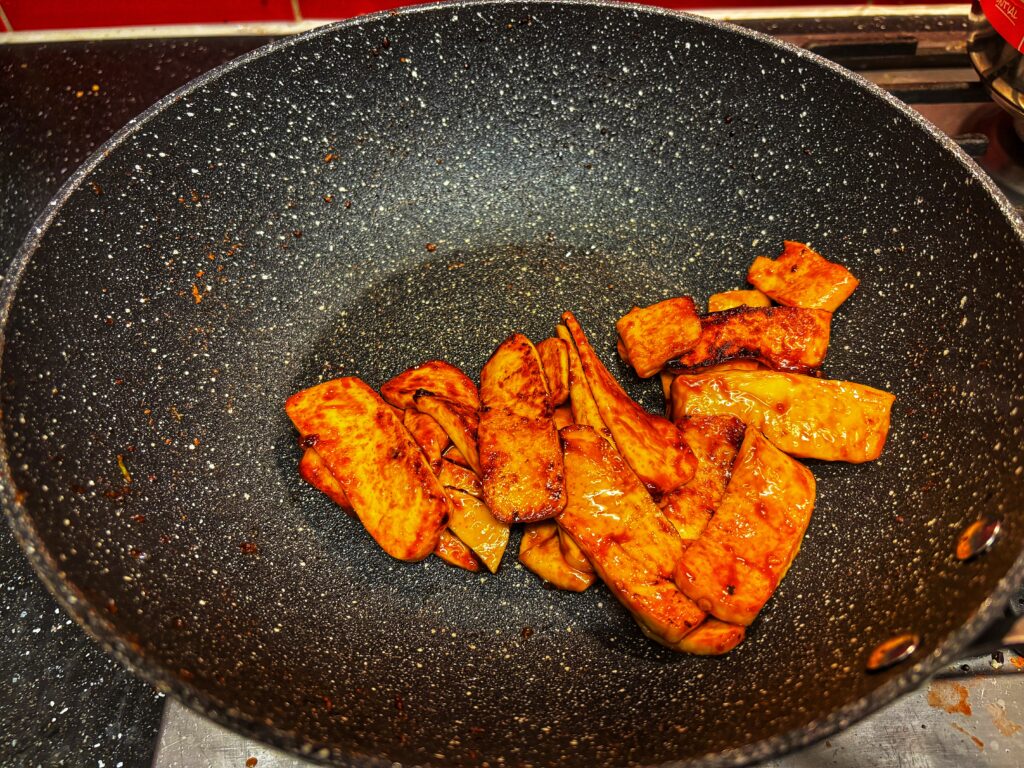
4️⃣ Prepare the veggies for the base and stir-fry
Cut the carrots into batons and the onions and bell peppers into long juliennes. Thinly slice or finely chop the garlic cloves. Finely chop the shallots and slice the birds’ eye chillies.
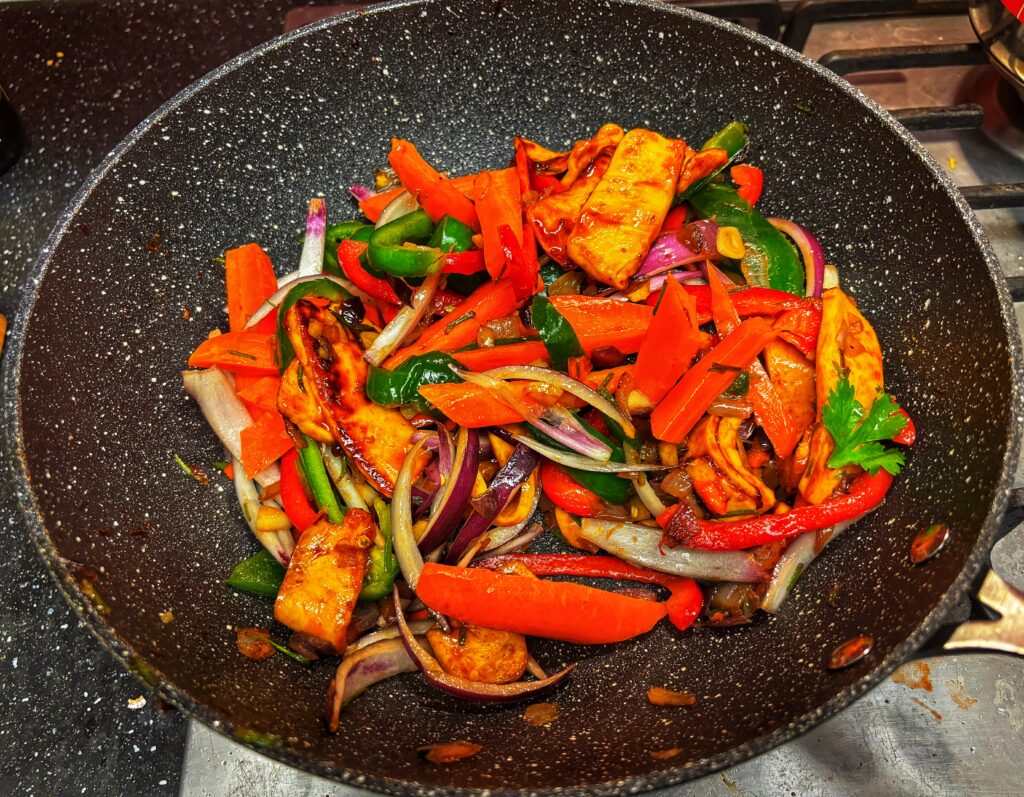
5️⃣ Get the base ready
Now, add 2 tbsp neutral oil to a wok and cook on high heat. Once the oil heats, add shallots, sliced chillies and finely chopped garlic, cumin powder and a pinch of palm sugar (optional). Once the shallots turn translucent, take the wok off the heat.
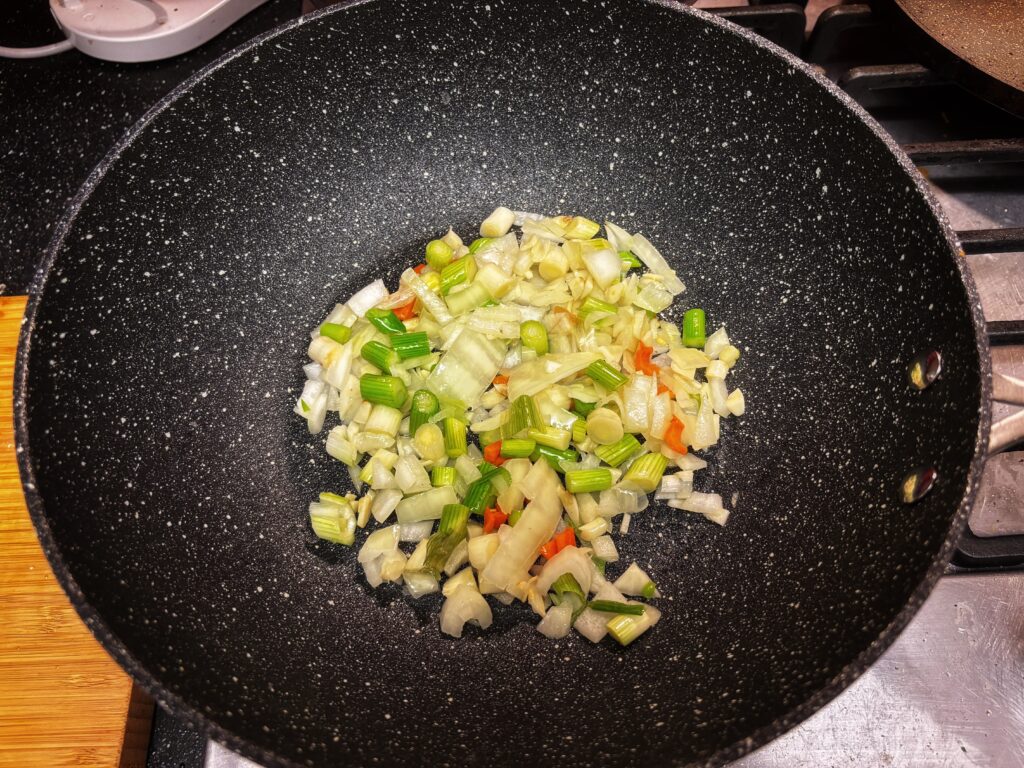
6️⃣ Add the veggies and protein
With the wok on a medium heat, add the paneer or tofu. Then add the carrots, onion and bell peppers. Finally, add the Thai sauce and combine well. Add salt to taste, if required.

7️⃣ Combine with the soaked noodles
Turn the heat to a high and add the noodles. Stir fry and toss well to ensure that the noodles are well coated in the Pad Thai sauce.
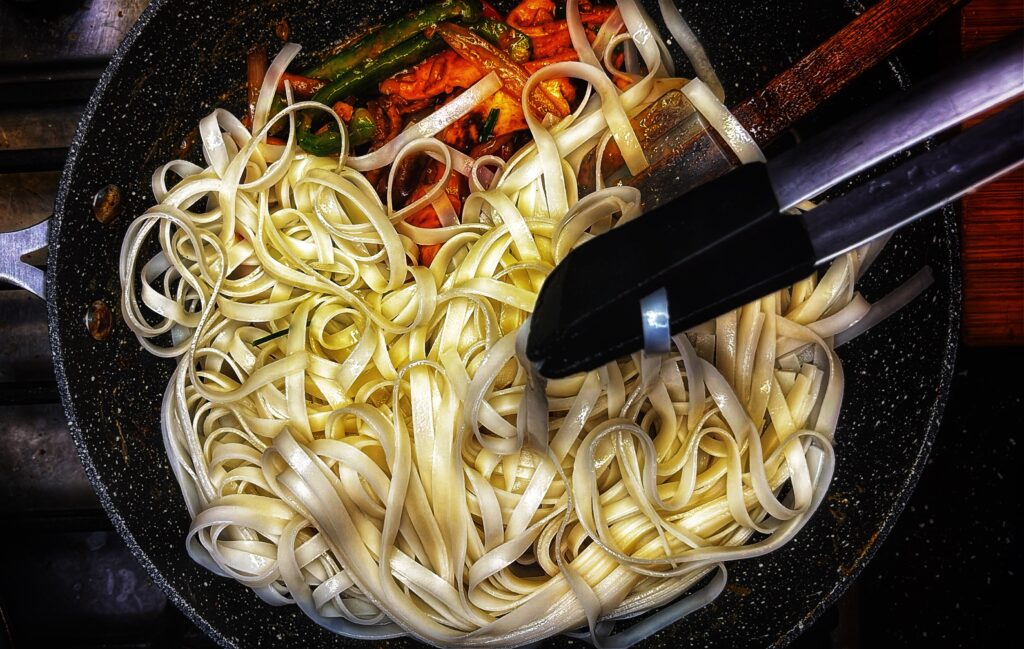
Add a splash (at most 1-2 tsp) of rice vinegar just before you take the noodles off the heat. This gives it the irrestible takeaway oomph. However, be careful to not overdo the vinegar as the vinegar tends to overpower the entire taste.
8️⃣ Garnish and serve
Top with mung beans, roughly chopped peanuts, chopped garlic chives and a dash of lemon. You can optionally add Thai chili oil to amp up the spice or include it as a condiment at the table.
Serve it fresh with a wedge of lemon on the side or pack it for a takeaway lunch.
Pad Thai Recipe | A 30-minute flavour bomb
Course: MainCuisine: ThaiDifficulty: Medium4
servings10
minutes20
minutes350
kcal8
hoursIngredients
- Noodles
c.350 g Pad Thai noodles (3 mm medium rice noodles)
- For the aromatic base
2 shallots, finely chopped
7-8 cloves purple garlic (or 3 cloves white garlic), finely chopped
2 Thai Bird’s Eye chilies, finely chopped (add more for higher heat or less if you prefer a mild dish)
½ tsp cumin powder
½ tsp palm sugar (optional)
- For the protein and veggies
2 carrots, chopped into very thin 2-inch batons
1.5 red bell pepper, julienned
1 white onion, julienned
250 g paneer or marinated tofu, thinly sliced
- For the Pad Thai sauce (prepare in advance in bulk)
4 tbsp Thai miso (Tao Jiew)
3 tbsp soy sauce (I use Chinese light soy sauce because it is quite similar to Thai soy sauce)
1.5 tbsp plain peanut butter
1 tsp palm sugar (or fine brown sugar)
½-1 tsp vegan fish sauce (optional; this is quite salty and you might want to use it sparingly if you are new to this ingredient)
- For the garnish and toppings
Splash of vinegar (1-2 tsp)
2-3 tbsp mung bean sprouts
2-3 tbsp chives, chopped
2-4 tbsp peanuts, roughly chopped
1 lime, wedged for serving
Directions
- Prepare the noodles
Use 75-90 g dry noodles per serve.
Method 1 (Soaking the noodles overnight): The most recommended method to get the best taste and texture is to soak the noodles overnight. Take a large bowl of cold water and soak the noodles for 8-10 hours. Drain the water and the noodles are ready to be tossed in. This acts slowly and makes the irresistibly chewy yet soft Pad Thai that Thai restaurants and takeaways seem to have.
Method 2 (Cooking the noodles in hot water): Soak the noodles in very hot water (70-80 degrees) for 45 minutes. This will result in chewy noodles but you might need to stir fry it in the wok for longer to make it soft. - Prepare the Thai Sauce (make it in bulk, recipe here)
This is something you can make in bulk and store for up to a month in the refrigerator. For this particular recipe, add 4 tbsp Tao Jiew to a bowl. Mash the beans with the back of your fork. Once they are almost mashed, add the 3 tbsp soy sauce, chopped chilies, palm sugar, vegan fish sauce, and peanut butter. Mix well till the peanut butter mixes with the rest of the ingredients to form a slurry. - Prepare the protein (prep the tofu by cold marinating it least 24 hours in advance)
This step depends on whether you are using paneer or tofu. Thinly slice 200 g of your chosen protein.
If you are using tofu: Add the tofu to an airtight container with 4 tbsp oyster sauce. Combine well and marinate it in the refrigerator for at least 2 hours. This lets the tofu absorb the umami-rich flavours of the vegetarian oyster sauce.
If you are using paneer: Heat a pan 2 tsp of neutral oil (I use olive oil). Brush the oil well to spread it evenly on the pan. Add the thinly sliced paneer and 4 tbsp oyster sauce. Cook on a high heat and flip every 2-3 minutes to ensure all the sides are well caramelised. - Prepare the veggies for the base and stir-fry: Cut the carrots into batons and the onions and bell peppers into long juliennes. Thinly slice or finely chop the garlic cloves. Finely chop the shallots and slice the birds’ eye chillies.
- Get the base ready: Now, add 2 tbsp neutral oil to a wok and cook on high heat. Once the oil heats, add shallots, sliced chillies and finely chopped garlic, cumin powder and a pinch of palm sugar (optional). Once the shallots turn translucent, take the wok off the heat.
- Add the veggies and protein: With the wok on a medium heat, add the paneer or tofu. Then add the carrots, onion and bell peppers. Finally, add the Thai sauce and combine well. Add salt to taste, if required.
- Combine with the soaked noodles: Turn the heat to a high and add the noodles. Stir fry and toss well to ensure that the noodles are well coated in the Pad Thai sauce.
Add a splash (at most 1-2 tsp) of rice vinegar just before you take the noodles off the heat. This gives it the irrestible takeaway oomph. However, be careful to not overdo the vinegar as the vinegar tends to overpower the entire taste. - Garnish and serve: Top with mung beans, roughly chopped peanuts, chopped garlic chives and a dash of lemon. You can optionally add Thai chili oil to amp up the spice or include it as a condiment at the table.
Serve it fresh with a wedge of lemon on the side or pack it for a takeaway lunch.
Notes
- Make it vegan: This Pad Thai recipe is vegan. We omit the seafood and fish sauce and use a natural vegan options like tofu for the chewy and smoky protein. Cold-marinating firm tofu for 24 hours in a mixture of soy sauce and vegan oyster sauce amps up the umami flavours.
- Make it gluten-free: Rice noodles is naturally gluten free. However, Tao Jiew and soy sauce tend to contain gluten. Therefore, you specifically need to source gluten-free soy sauce. The same is applicable for vegan fish sauce. Veggie oyster sauce may also contain traces of wheat so it is best to buy from a brand that specifically supplies gluten-free sauce. Certain brands like Lee Kum Kee offer gluten-free alternatives for most of these sauces. Finally, do note that Tao Jiew always contains wheat. You can substitute this 1:1 with white miso. Gluten-free miso is available in most supermarkets.
- Make it nut-free: If you are allergic to nuts, this might not be the most suitable recipe. This is because most Asian condiments have cross-contamination with peanuts. However, if you can find nut-free vegan fish sauce, oyster sauce, Tao Jiew and soy sauce, you can make this recipe completely nutfree by using sunflower butter instead of peanut butter. Skip the garnish with roasted and salted peanuts. Instead, you can garnish with lightly roasted pumpkin and sunflower seeds.
Looking for more recipes with the Thai sauce that you made in bulk? Try the super popular weeknight dinner, The Thai Basil Fried Rice.
If you loved this recipe and want something quick using ingredients from supermarkets, try out this Thai-inspired 30-minute Silky Coconut Mushroom Soup.
Let me know if this rivalled your favourite Thai takeaway or neighbourhood Thai restaurant in the comments below!

